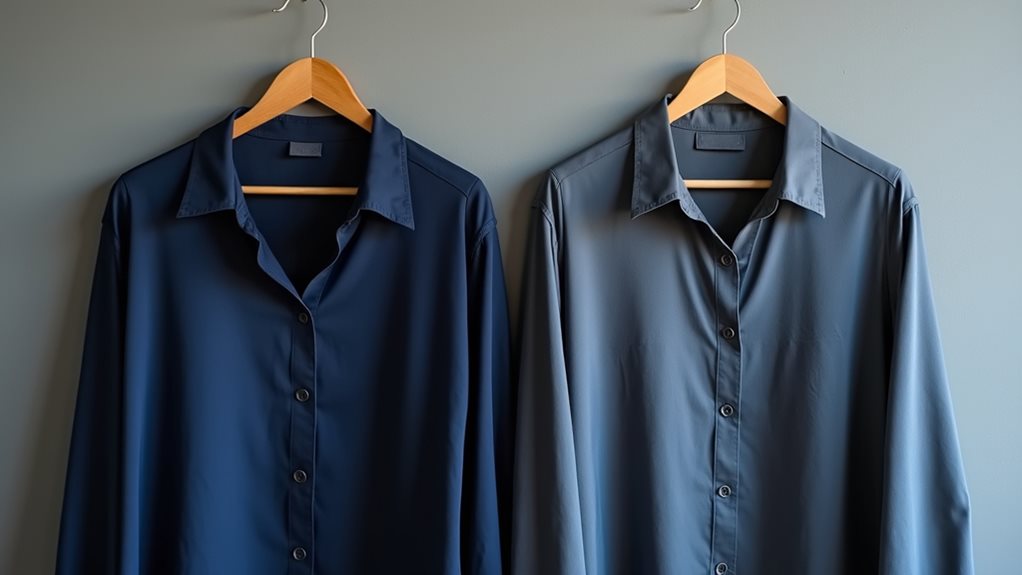Yes, dry cleaning can definitely change your garment’s color, and I’ve watched too many favorite pieces come back looking dull or faded. Dirty solvents steal vibrancy and deposit colors from previous items, while harsh chemicals like perchloroethylene react with fabric dyes, causing bleeding and gradual fading over time. Poor-quality cleaners might even ignore “dry clean only” labels and use wet cleaning methods that ruin delicate fabrics. Understanding these risks helps you protect your wardrobe’s original beauty.
How Dirty Dry Cleaning Solvent Affects Garment Colors
While most people assume that dry cleaning automatically preserves their garments’ colors, the truth is that dirty solvents can actually steal the vibrancy right from your favorite pieces, leaving you with clothes that look like they’ve been through a washing machine filled with muddy water.
When dry cleaning solvents become contaminated with extracted dyes from previous garments, they’re fundamentally doing double duty – cleaning your clothes while simultaneously depositing someone else’s color onto them.
Think of it like washing dishes in dirty water; you’re not really cleaning anything, just redistributing the grime.
Dark garments suffer the most, emerging from contaminated solvents looking dull and lifeless, their rich colors literally dissolved into the murky cleaning fluid.
Beyond color changes, exposure to traditional dry cleaning chemicals like perchloroethylene has raised health concerns, prompting many facilities to switch to safer cleaning alternatives.
The Impact of Non-Chemically Inert Solvents on Fabric Dyes
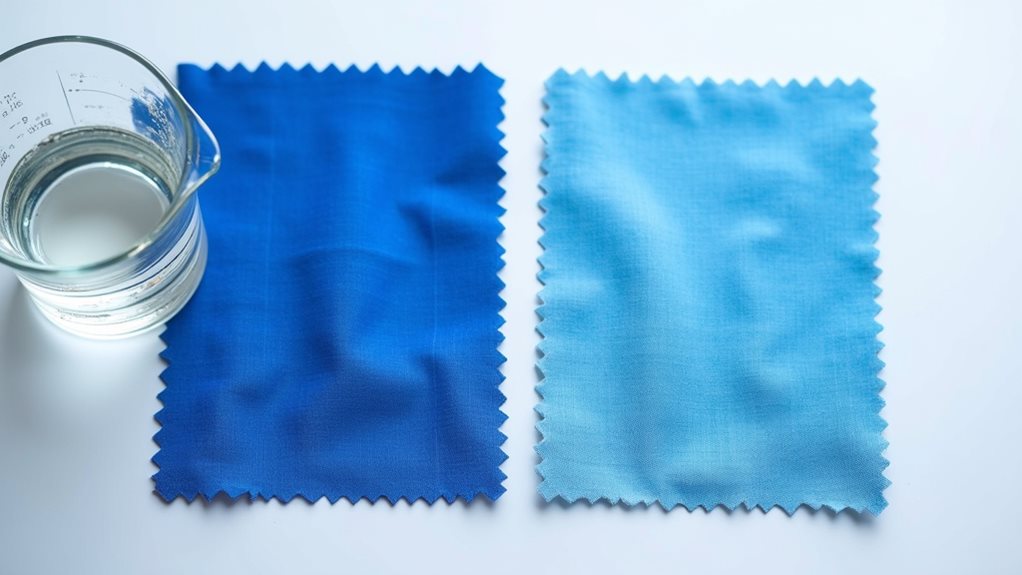
Beyond dirty solvents lurking in dry cleaning machines, there’s an even more fundamental problem that most people don’t realize exists – the very chemicals used to clean your clothes might be waging a silent war against your garment’s dyes.
Imagine this: you drop off your favorite red dress, and it comes back looking like a faded Valentine’s Day card 💔.
Here’s the kicker – about 95% of dry cleaners use solvents like perchloroethylene that literally react with fabric dyes, causing bleeding, pulling, and fading. Your pink blouse becomes salmon, your navy suit turns grayish-blue.
It’s chemistry gone rogue! Smart dry cleaning operations use siloxane-based fluids that don’t chemically react with dyes, preserving your garment’s original vibrancy and extending its lifespan considerably.
While professional dry cleaning is generally gentler than traditional washing, repeated exposure to cleaning solvents can still cause gradual color fading over time, particularly affecting vibrant reds and dark blues.
Why Some Cleaners Wash Instead of Dry Clean Your Garments
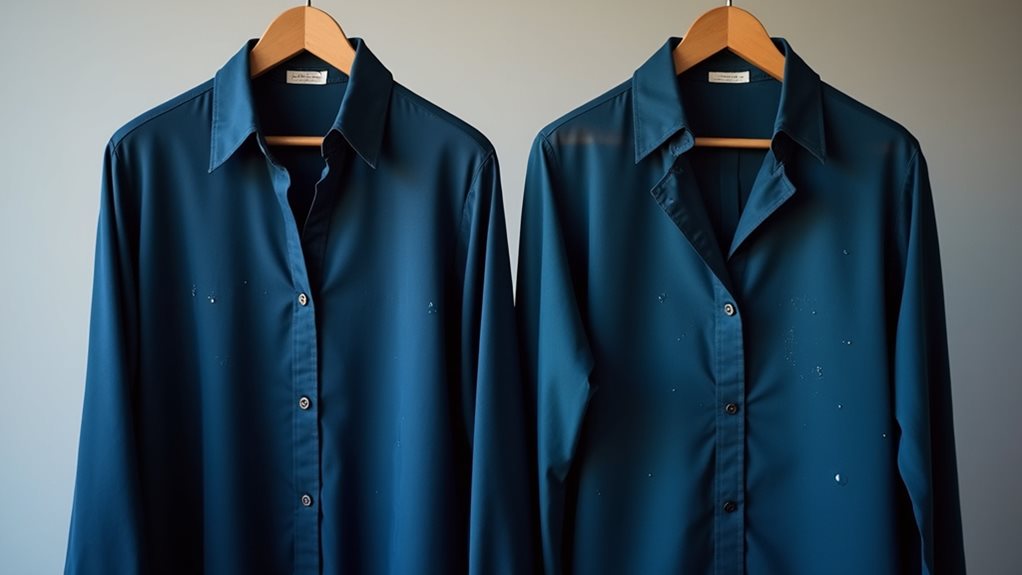
Although your care label clearly states “dry clean only,” some cleaners will toss your garment into a washing machine anyway, treating it like everyday laundry – and the results can be absolutely heartbreaking 😢.
Sometimes this happens because of miscommunication or rushed staff who misinterpret the care instructions, thinking they’re saving you money with their “wet cleaning” alternative.
Rushed staff often misinterpret care labels, believing their wet cleaning shortcuts will save you money instead of ruining your garments.
Your dry cleaner might genuinely believe they’re helping, but when those dark cotton pieces emerge looking faded and lifeless, or your delicate blouse’s pink flowers turn ghostly white, you’ll wish they’d followed the rules.
That’s why I always emphasize pointing out specific care requirements when dropping off garments, because preventing this mishap is much easier than explaining why your favorite dress now looks completely different.
While improper cleaning methods can ruin your clothes’ appearance, many modern cleaners now offer eco-friendly solvents that provide safer alternatives to traditional chemical processes without compromising cleaning quality.
Visual Signs That Your Cleaner Is Using Poor Quality Solvent
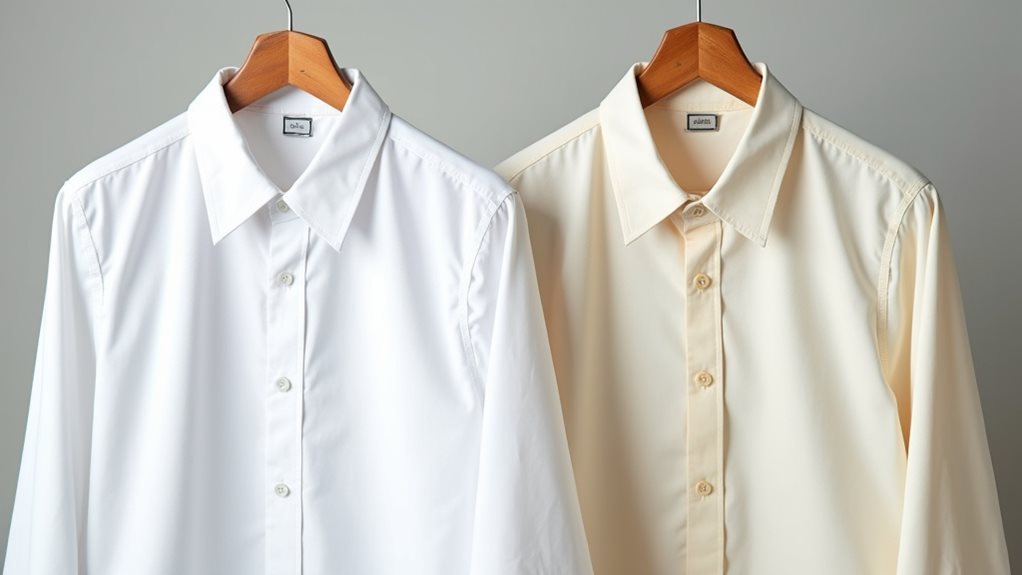
Even when your cleaner promises to follow proper dry cleaning procedures, you can actually spot telltale signs of corner-cutting by paying attention to one simple detail that most people never think to check.
Here’s my insider secret: ask to see their cleaning solvent after they’ve processed dark garments. Quality dry cleaners using proper filtration and fresh solvents will show you crystal-clear fluid that looks absolutely pristine, indicating zero color loss from your clothes.
However, if you notice any discoloration, cloudiness, or murky appearance in that solvent, you’re witnessing dye extraction happening in real-time – your garments’ colors are literally dissolving into their dirty cleaning solution.
This visual assessment becomes your foolproof method for evaluating whether they’re truly protecting your investment pieces. Professional dry cleaning relies on chemical solvents like perchloroethylene or newer eco-friendly alternatives to safely remove stains without the fabric damage that water-based washing can cause.
Common Household Products That Cause Color Loss
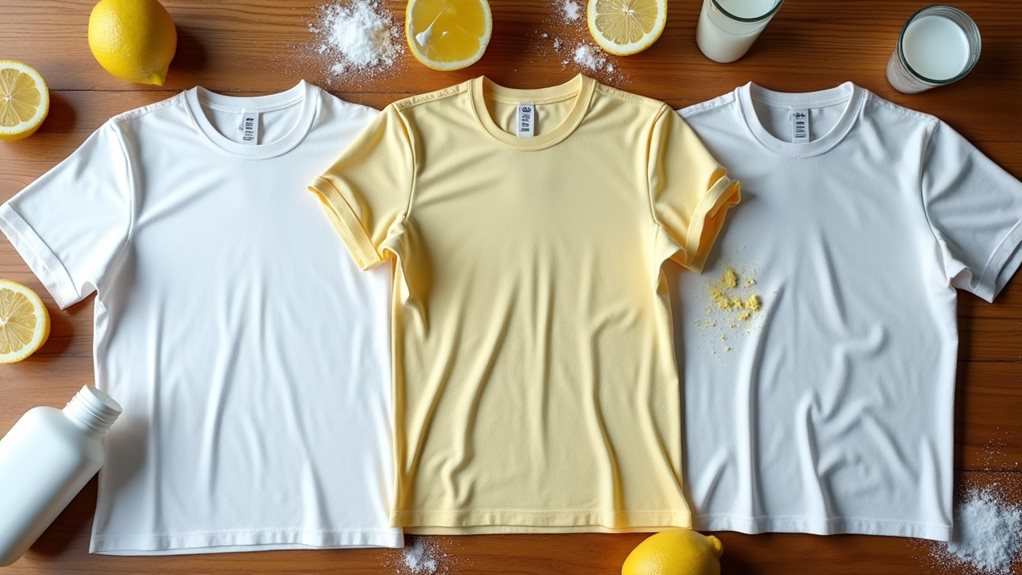
What surprises most people is that the biggest threat to their favorite garments isn’t lurking at the dry cleaner’s shop, but rather sitting innocently on their own bathroom counter, kitchen shelf, or vanity table.
Your bleach-based cleaners can strip fabric dyes faster than you’d imagine, while that alcohol-laden hairspray you love creates permanent discoloration on delicate pinks and reds.
Perfumes and hand sanitizers containing alcohol also wreak havoc, leaving behind mysterious spots that’ll puzzle even experienced professionals during the cleaning process.
When spills happen—and they will—resist the urge to rub frantically; instead, gently blot the area to minimize damage.
While traditional dry cleaning solvents like perchloroethylene (PERC) can occasionally cause color changes, eco-friendly alternatives such as wet cleaning and liquid CO2 are gentler on both fabrics and your health.
Sometimes our daily beauty routines become our wardrobe’s worst enemy!
Why White Garments Turn Gray After Cleaning
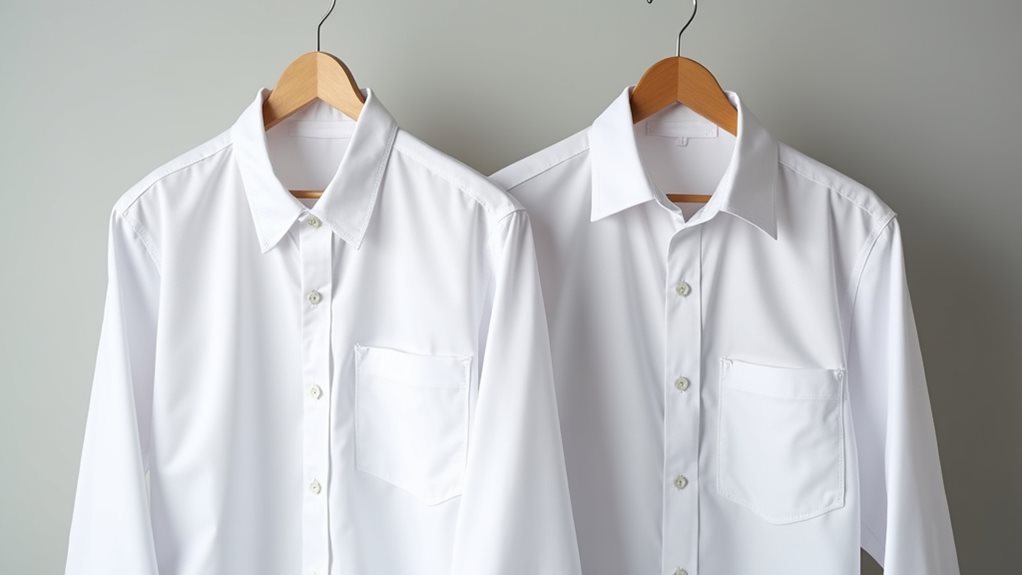
Nothing breaks your heart quite like pulling your favorite white shirt from the dry cleaner’s bag, only to discover it’s taken on an unwelcome grayish tinge that wasn’t there before.
When your whites have faded after dry cleaning, you’re witnessing one of two culprits at work.
First, those fluorescent brighteners that made your garment gleam white are decomposing from heat, light, or simply aging out, leaving behind dull yellow-green undertones that’ll make you question everything.
Second, soils and impurities are redepositing during cleaning when the solvent isn’t properly filtered or your dry cleaner overloads their machines.
The good news? Sometimes re-cleaning in fresh, clear solvent can restore your garment’s former glory.
Additionally, chemical solvents used in dry cleaning aren’t designed to tackle water-based stains like sweat and antiperspirant residue, which can build up over time and contribute to yellowing or graying of white fabrics.
Protecting Your Clothes From Fading and Discoloration

You’ve probably experienced that sinking feeling when your favorite black dress emerges from cleaning looking more charcoal than midnight, and trust me, I’ve been there too many times to count.
The truth is, protecting your clothes from fading and discoloration starts with understanding that solvent quality matters more than you might think, because clean, crystal-clear dry cleaning fluids maintain those vibrant colors you love.
When you choose proper care and prevention methods, like finding a cleaner who uses non-reactive solvents and follows garment care instructions religiously, you’re fundamentally giving your wardrobe the best chance to stay beautiful for years to come.
Unlike traditional washing methods, dry cleaning uses chemical solvents instead of water to prevent the color bleeding and fading that commonly occurs with water-based cleaning processes.
Solvent Quality Matters
When I first started paying attention to dry cleaning quality, I learned the hard way that not all solvents are created equal, and the difference between crystal-clear cleaning fluid and that murky, discolored stuff can make or break your favorite garments.
You’ll want to ask about their solvent quality – trust me on this one! Clean, transparent solvents like siloxane won’t react with your clothes’ dyes, while common perchloroethylene can cause serious color bleeding.
I’ve seen too many “manufacturer defect” claims that were actually solvent-related damage 😬.
Look for dry cleaners using crystal clear fluid, because discolored solvents are basically dye-stealing villains in disguise. Your dark garments will thank you later!
The best dry cleaning establishments prioritize chemical stability in their solvents, ensuring consistent results without unexpected reactions that could alter your clothing’s appearance.
Proper Care Prevention
After watching my favorite cashmere sweater transform from deep navy to an unfortunate grayish-blue during what should have been routine maintenance, I’ve become something of a preventive care evangelist – because honestly, protecting your clothes from color disasters is so much easier than trying to fix them afterward.
Here’s your color-protection action plan:
- Read that care label religiously – it’s your garment’s survival guide, not a suggestion
- Store clothes in cool, dark closets away from sunlight that’ll bleach your favorites faster than you can say “oops”
- Clean promptly after wearing since perspiration and mystery stains love wreaking havoc on dye stability
Always communicate with your dry cleaner about spills or previous color issues, and seek out establishments using non-reactive solvents like siloxane for gentler treatment.
While dry cleaning’s chemical solvents are gentler on fabrics and dyes than water-based washing, making it particularly beneficial for delicate materials like silk and wool, it still doesn’t completely prevent gradual fading over time.

